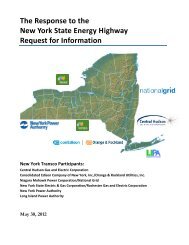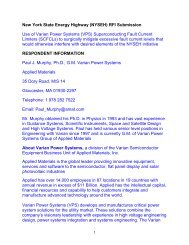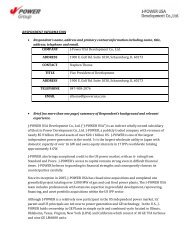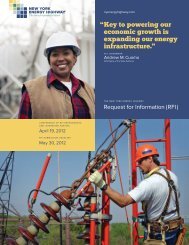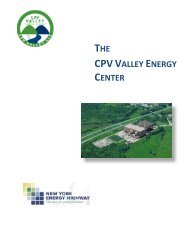Silicon Solution Joint Venture, LLC - Energy Highway
Silicon Solution Joint Venture, LLC - Energy Highway
Silicon Solution Joint Venture, LLC - Energy Highway
You also want an ePaper? Increase the reach of your titles
YUMPU automatically turns print PDFs into web optimized ePapers that Google loves.
US SOLAR – WHITE PAPER 24 May 2012<br />
3.2. Investors' roles in these business models<br />
The various solar business models present different opportunities for investor participation. Table<br />
2 outlines the advantages and disadvantages of each for prospective investors.<br />
Table 2: Investors' roles in range of solar business models<br />
Business<br />
model<br />
Potential role for investors Advantages for investors Disadvantages for investors<br />
Host-owned<br />
• Host, own, and receive<br />
electricity from the asset,<br />
capture the ITC<br />
• Protects investor from retail electricity<br />
costs (since investor is the solar power<br />
consumer)<br />
• Maximises project value as there are no<br />
'frictional' costs paid to other parties<br />
• Limited to hosts able to afford upfront cost<br />
and monetise the ITC<br />
• Exposes investor to project-specific risk<br />
without the benefit of diversification<br />
Independent<br />
power<br />
producer<br />
(IPP) power<br />
purchase<br />
agreement<br />
(PPA)<br />
• Provide cash equity, tax<br />
equity, or debt to the project<br />
• Provide cash equity or debt<br />
(back leverage) to the<br />
developer<br />
• Purchase securities (eg,<br />
bonds) backed by the project<br />
• Allows investor to enter project<br />
development at desired stage to obtain<br />
preferred risk/return<br />
• Risk evaluation for individual projects is<br />
easier than for project portfolios<br />
• Exposes investor to project-specific risks<br />
(eg, plant performance, offtaker<br />
creditworthiness, manufacturer warranties)<br />
• Nascent project bond market currently<br />
makes investment via capital markets<br />
difficult<br />
Vertical and<br />
semi-vertical<br />
• Risk evaluation is easier due to<br />
standardised PPAs/leases and contracts<br />
arranged by single third-party financier<br />
• Contract standardisation can open<br />
market up to solar-backed securitisation<br />
• Opacity between the investor and the thirdparty<br />
financier can allow the latter to realise<br />
higher returns on the margin between<br />
PPA/lease revenue and financing costs<br />
Semivertical<br />
only<br />
• Provide tax equity to the<br />
portfolio (most common)<br />
• Provide cash equity or debt<br />
to the portfolio (uncommon)<br />
• Purchase securities (eg,<br />
collateralised loan<br />
obligations) backed by the<br />
portfolio<br />
• Competition among installers drives<br />
down installation costs and reduces<br />
upfront cost per lease/PPA, all else equal<br />
• Business model relies on relationships with<br />
installers, opening up risk that installers<br />
cannot deliver on commitments<br />
• Use of different contracted parties for<br />
installation and O&M creates uncertainty<br />
Semivertical<br />
and<br />
finance<br />
market<br />
• Use of different contracted parties for<br />
installation and O&M creates uncertainty<br />
Finance<br />
market<br />
• Investors can specify project criteria (eg,<br />
minimum host credit score, geography)<br />
• Intermediary is an independent third<br />
party and will not negotiate down tax<br />
equity investor's yield (whereas a project<br />
sponsor or third-party financier might)<br />
• Inherent competition brings down overall<br />
yields<br />
Source: Bloomberg New <strong>Energy</strong> Finance<br />
4. INVESTORS, VEHICLES, AND THE EVOLUTION OF SOLAR<br />
FINANCING<br />
Five major drivers suggest that there may be an expanded role for new types of investors behind<br />
US solar projects:<br />
1. Diminished appetite from the historically most active investors, such as banks and the<br />
government (Section 2.1 above)<br />
2. The success of emerging business models for solar deployment (Section 3 above)<br />
3. The basic characteristics of solar assets (potential for high returns for early-stage equity<br />
investors; likelihood of steady, high single-digit returns for owners and creditors of operating<br />
projects)<br />
4. Momentum behind development of new types of high-liquidity financing vehicles (Section 4.4<br />
below)<br />
5. Recognition that the clean energy sector overall, which has surpassed $1 trillion in cumulative<br />
investment since 2004 and grew by $260bn last year, will need to increasingly draw from the<br />
massive reserves of wealth managed by institutional and other investors in order to continue<br />
to fund this tremendous growth (Figure 13)<br />
© Bloomberg New <strong>Energy</strong> Finance 2012<br />
Strictly no copying, forwarding, shared passwords or redistribution allowed without prior written permission<br />
of Bloomberg New <strong>Energy</strong> Finance. For more information on terms of use, please contact<br />
sales.bnef@bloomberg.net. Copyright and Disclaimer notice on page 28 applies throughout. Page 10 of 28



